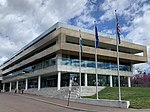Washington Harbour

Washington Harbour is a Class-A mixed-use development located at 3000 and 3050 K Street, N.W., in Washington, D.C., in the United States. The southern edge of the development borders the Potomac River on the Georgetown waterfront. Designed by Arthur Cotton Moore, the complex consists of two curved towers and three other buildings attached to them, all of which are in the Postmodern architectural style. The complex contains luxury condominia, offices, retail space, restaurants, and underground parking. Construction of the complex was preceded by a seven-year zoning and legal battle over the future of the Georgetown waterfront. This dispute led to the designation and development of a new national park, the Georgetown Waterfront Park. A two-year controversy over the design of the complex, which included accusations of malfeasance by a D.C. agency, followed. Construction began in November 1981, and was complete in June 1986. Critical reception of Washington Harbour was mixed, but the public quickly embraced it. Washington Harbour suffered significant management problems in its first two years, which led to the removal of one of its developers as property manager. The complex was sold to local real estate magnate Conrad Cafritz in 1988 in a controversial purchase-like lease agreement. Cafritz subsequently sold the property, which has had six different owners between 1990 and 2013. It was put up for sale again in 2013. Washington Harbour has a first-of-its kind set of floodgates designed to help protect it against Potomac River floods. However, failure to use the floodgates properly caused a major flood in 2011, which led to a lawsuit and a $30 million renovation.
Excerpt from the Wikipedia article Washington Harbour (License: CC BY-SA 3.0, Authors, Images).Washington Harbour
K Street Northwest, Washington Georgetown
Geographical coordinates (GPS) Address Nearby Places Show on map
Geographical coordinates (GPS)
| Latitude | Longitude |
|---|---|
| N 38.901796 ° | E -77.060086 ° |
Address
K Street Northwest 3000
20566 Washington, Georgetown
District of Columbia, United States
Open on Google Maps







